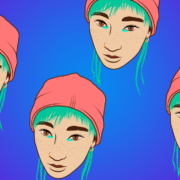Japan, the year is 2005. The makeup of the rap scene is the same as it is everywhere, predominantly male. Women* only have a chance to make it in the business if their performance is completely focused on “Kawaii” style, to hit the nail on that they have to put on extreme (even childish makeup) wear infantile costumes and prance around the stages of the country with happy-go-lucky pop music.
The “B-Boy Park” MC-Battle is happening in the Yoyogi Park in Tokyo, one of the most prestigious battle rap events of the country. The finale of the battle is going to happen in an old and considered holy by many, sumo stadium. However, there is one problem: Traditionally, women are not allowed to enter the ring, but the first female who has ever entered this battle rap competition made it directly into the final round. The then 20-year-old Coma-Chi. The promoters are pondering whether they should cancel the finale because Coma-Chi is a woman. Eventually, they make the finale possible, but they make it mandatory for Coma-Chi not to rap in high heels. Coma-Chi raps barefoot anf loses – but with her performance, she runs over all the barriers for other female MCs in Japan.
In 2006 she releases her first album “Day before blue” with which she enhances the Japanese rap scene with her female perspective and her unique Boom-Bap-Sound significantly. While Coma-Chis earlier albums were reminiscent of those of big players from the Philadelphia scene, her music, as well as her lyrics, changed after the nuclear catastrophe in Fukushima from 2011. “After the catastrophe, my view on music and society has changed fundamentally”, says Coma-Chi during the interview with 365 Female MCs. After the 3rd of November (day of the nuclear reactor accident, Ed.) I noticed, how much was going completely wrong in Japanese politics and society. This marked the point in time when I felt the urge to learn more about the world and the social situation in general.” The accident inspired her to write the book “The Boy that Called The Sun”. In the anti-capitalist and consumption-critical novel she tells the story of a boy who wants to heal his parents from the ailment of the “American Dream”. The book ends with the parents waking up their child, having their minds made up to flee the capitalistic achievement-oriented society and live a life in harmony with nature.
Nature and recentering herself in it became Coma-Chi‘s keynote in her musical output since 2011. Her album, “Jomon Green” is coined by a lyrical recollection on the Jomon- Period, from 14.00 BC until 300 BC, in which Japanese society consisted of hunters and gatherers and the first little settlements were newly risen. For Coma-Chi this time is a paragon of living close to nature. On “Jomon Green” Coma-Chi leaves the path of traditional hip hop and ventures into electronical and spherical soundscapes which provide the album with an incomparable atmosphere. Coma-Chi in part raps classical rap parts but she is also crossing the lines into the realms of the spoken word. The album should persuade the listeners to recognize the godlike presence of nature that is surrounding us and not exploit it in any way further. In the meantime, her music has shifted far away from her Boom-Bap-Roots, in February of 2020, she released a song together with Japanese Jazz legend Uyama Hiroto called “The Dawn of Reiwa”. Coma-Chi raps and sings in this song as if she had to tell the world so much more: And especially we in the Western hemisphere, should listen a lot closer to her message.



